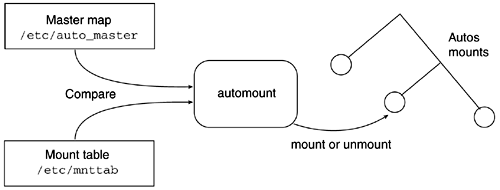Components of the Automounter |
The automounter uses the following three components.
The automount command— Installs autofs mount points and associates an automount map with each mount point.
The autofs file system— Monitors attempts to access directories within the file system and notifies the automountd daemon.
The automountd daemon— An RPC server that answers file system mount and unmount requests from autofs.
The automount Command
The automount command is called at system startup by the /etc/init.d/autofs script. (This script also starts the automountd daemon.) The automount command reads the auto_master map file to create the initial set of autofs mount points, as shown in Figure 26, and then terminates. These mount points are only created at startup time (no file systems are mounted) and are subsequently used to mount file systems as requested by users. These mount points are also known as trigger nodes.
Figure 26. How Autofs Uses the auto_master Map

The automount command checks the /etc/nsswitch.conf file to determine which auto_master file to use: files, nis, nisplus, or ldap. The automount command does not read the /etc/vfstab file.
After system startup, you can run the automount command manually, as needed, to re-read the auto_master map and update any revised or new indirect maps.
The Autofs File System
Autofs is a kernel file system that supports automatic mounting and unmounting. When a user makes a request to access a file system at an autofs mount point, autofs performs the following tasks.
Autofs intercepts the request.
Autofs sends a message to automountd to mount the requested file system.
automountd locates the file system information in a map, creates the trigger nodes (if necessary), and performs the mount.
Autofs enables the intercepted request to proceed.
After a period of inactivity (the default is five minutes), autofs unmounts the file system.
The automountd Daemon
Starting with the Solaris 2.5 release, the automountd daemon is completely independent of the automount command. Because of this separation, you can add, delete, or change map information without needing to stop and start the automountd process.
The automountd daemon is started at boot time by the /etc/init.d/autofs script (which also runs the automount command, reads the master map, and installs autofs mount points).
The automountd daemon subsequently responds to requests intercepted by autofs, locates the file system information in a map, creates the trigger nodes, and performs the mount.
